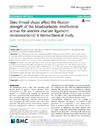Please use this identifier to cite or link to this item:
https://accedacris.ulpgc.es/jspui/handle/10553/55100
| Title: | Does thread shape affect the fixation strength of the bioabsorbable interference screws for anterior cruciate ligament reconstructions? A biomechanical study | Authors: | Garcés, Gerardo L. Martel, Oscar Yánez, Alejandro Cuadrado, Alberto |
UNESCO Clasification: | 3314 Tecnología médica | Keywords: | Anterior cruciate ligament ACL reconstruction Interference screw Biomechanical testing |
Issue Date: | 2019 | Project: | Convenio de Colaboración Entre Traumaquir, la Universidad de las Palmas de Gran Canaria y la Fundación Canaria Parque Científico Tecnológico de la Universidad de las Palmas de Gran Canaria Para la Realización del Proyecto de Investigación “Valoración de Pruebas Diagnósticas y Resultados de Diversas Patologías del Aparato Locomotor” | Journal: | BMC Musculoskeletal Disorders | Abstract: | Background: The purpose of this study was to compare the biomechanical behaviour of two bioabsorbable interference screws with different geometries. Methods: Two different pitch (2.5 and 5 mm) bioabsorbable interference screws, both 9 × 30 mm, were tested. Tests were performed with forty bovine digital extensor tendons and skeletally mature porcine tibiae. Two protocols of cyclic tests at 1 Hz were performed: 1000 cycles from 50 to 250 N, and 5000 cycles from 100 to 300 N (n = 10 for each type of test and screw). After the cyclic loading, a final ramp displacement until failure at 0.5 mm/s was applied. Results: The stiffness after the cyclic phase of the tests was not statistically different between the two screws (1000th cycle: 2.5 mm pitch 280.3 ± 56.4 N/mm, 5 mm pitch 275.2 ± 65.0 N/mm, P = .965; 5000th cycle: 2.5 mm pitch 281.3 ± 66.4 N/mm, 5 mm pitch 286.1 ± 79.4 N/mm, P = .814). The yield load was not significantly different between the screws (1000 cycle tests: 2.5 mm pitch 482.2 ± 120.2 N, 5 mm pitch 495.9 ± 131.3 N, P = .508; 5000 cycle tests: 2.5 mm pitch 476.4 ± 65.3 N, 5 mm pitch 494.3 ± 39.2 N, P = .391). No correlation was found between the insertion torque and yield load (1000 cycle tests, R2 = 0.013; 5000 cycle tests, R2 = 0.006). Conclusions: The pitch of bioabsorbable interference screws does not seem to affect fixation strength. Also, the authors recommend not to use insertion torque alone to estimate the fixation strength. | URI: | https://accedacris.ulpgc.es/handle/10553/55100 | ISSN: | 1471-2474 | DOI: | 10.1186/s12891-019-2435-1 | Source: | BMC Musculoskeletal Disorders [ISSN 1471-2474], v. 20 (1):60 |
| Appears in Collections: | Artículos |
SCOPUSTM
Citations
6
checked on Jun 8, 2025
WEB OF SCIENCETM
Citations
5
checked on Jun 8, 2025
Page view(s)
203
checked on Sep 21, 2024
Download(s)
181
checked on Sep 21, 2024
Google ScholarTM
Check
Altmetric
Share
Export metadata
Items in accedaCRIS are protected by copyright, with all rights reserved, unless otherwise indicated.
